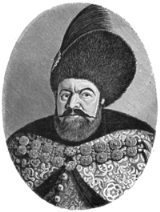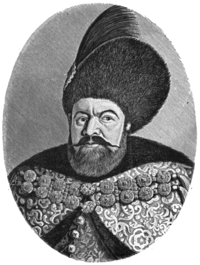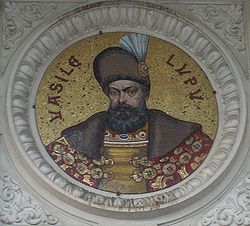
Vasile Lupu
Encyclopedia

Moldavia
Moldavia is a geographic and historical region and former principality in Eastern Europe, corresponding to the territory between the Eastern Carpathians and the Dniester river...
n Voivode (Prince) between 1634 and 1653. Vasile Coci surnamed "the wolf" who ruled as Prince of Moldavia had secured the Moldavian throne in 1634 after a series of complicated intrigues and managed to hold it for twenty years. Vasile was of Albanian
Albanians
Albanians are a nation and ethnic group native to Albania and neighbouring countries. They speak the Albanian language. More than half of all Albanians live in Albania and Kosovo...
origin and Greek
Greeks
The Greeks, also known as the Hellenes , are a nation and ethnic group native to Greece, Cyprus and neighboring regions. They also form a significant diaspora, with Greek communities established around the world....
education. He was a capable administrator and a brilliant financer and soon was the richest man in the Christian East. Judiciously placed gifts kept him on good terms with the Ottoman authorities.
Early life
Lupu was born in Arbanasi, an AlbanianAlbanians
Albanians are a nation and ethnic group native to Albania and neighbouring countries. They speak the Albanian language. More than half of all Albanians live in Albania and Kosovo...
village in Bulgaria
Bulgaria
Bulgaria , officially the Republic of Bulgaria , is a parliamentary democracy within a unitary constitutional republic in Southeast Europe. The country borders Romania to the north, Serbia and Macedonia to the west, Greece and Turkey to the south, as well as the Black Sea to the east...
. The first time that the last name of the family is mentioned in Romanian sources is in 1597, when Nicholas Coci, an Albanian born in Epirus
Epirus (region)
Epirus is a geographical and historical region in southeastern Europe, shared between Greece and Albania. It lies between the Pindus Mountains and the Ionian Sea, stretching from the Bay of Vlorë in the north to the Ambracian Gulf in the south...
, takes refuge with other mercenaries in the Arbanasi village. After he had been involt in a revolt and he was defeated, Nicolai Coci was brought in Romanian Country by Radu Mihnea, who would occupy the throne of all Romanian Territories (Moldova, Transilvania, Muntenia) in 1601. Nicolai Coci had 8 children: Vasile Lupu, Gabriel Hatmanul, Ilinca, Marga, Anna, Catherine and George Costea. After father's death, the family moved to live in Moldavia. The most important aspect of Nicolai Coci (Nicholas Coci) ... he is the father of Prince Vasile Lupu / Wolf (Vasile Coci). The Coci last name was carried on by Stefan Coci (son of Vasile Lupu) who married the daughter of Petru Rareş
Petru Rares
Peter IV Rareș was twice voievod of Moldavia: 20 January 1527 to 18 September 1538 and 19 February 1541 to 3 September 1546. He was an illegitimate child born to Ștefan cel Mare...
, a voivode of Moldavia, but also by the descendants of Gabriel Coci named Hatmanul. The descending line of Coci intersects with aristocratics families from Moldavia, old families such as Bucioc, Boulesti, and the Abazesti.
Reign

Greeks
The Greeks, also known as the Hellenes , are a nation and ethnic group native to Greece, Cyprus and neighboring regions. They also form a significant diaspora, with Greek communities established around the world....
and Levant
Levant
The Levant or ) is the geographic region and culture zone of the "eastern Mediterranean littoral between Anatolia and Egypt" . The Levant includes most of modern Lebanon, Syria, Jordan, Israel, the Palestinian territories, and sometimes parts of Turkey and Iraq, and corresponds roughly to the...
ine competition. This was because Vasile Lupu had led a rebellion against Alexandru Iliaş and his foreign retinue
Retinue
A retinue is a body of persons "retained" in the service of a noble or royal personage, a suite of "retainers".-Etymology:...
, being led into exile
Exile
Exile means to be away from one's home , while either being explicitly refused permission to return and/or being threatened with imprisonment or death upon return...
by Moise Movilă
Moise Movila
Moise Movilă was Voivode of Moldavia twice: between April 28, 1630 and November 1631, and between July 2, 1633 – April 1634. Of the Movileşti boyar and princely family, Moise was Simion Movilă's son and brother of Gabriel Movilă and Mihail Movilă.He obtained the throne from the Ottoman overlord...
(although he was backed by Prince Matei Basarab
Matei Basarab
Matei Basarab was a Wallachian Voivode between 1632 and 1654.-Reign:Much of Matei's reign was spent fighting off incursions from Moldavia, which he successfully accomplished in 1637, 1639, and 1653 - see Battle of Finta...
and the powerful Pasha
Pasha
Pasha or pascha, formerly bashaw, was a high rank in the Ottoman Empire political system, typically granted to governors, generals and dignitaries. As an honorary title, Pasha, in one of its various ranks, is equivalent to the British title of Lord, and was also one of the highest titles in...
of Silistra
Silistra
Silistra is a port city of northeastern Bulgaria, lying on the southern bank of the lower Danube at the country's border with Romania. Silistra is the administrative centre of Silistra Province and one of the important cities of the historical region of Southern Dobrudzha...
, Mehmet Abza).
His rule was marked by splendor and pomp. He was a builder of notable monuments (the unique Trei Ierarhi Monastery
Trei Ierarhi Monastery
Biserica Trei Ierarhi is a seventeenth-century monastery located in Iaşi, Romania. The monastery is listed in the National Register of Historic Monuments and included on the tentative list of UNESCO World Heritage Site....
in Iaşi
Iasi
Iași is the second most populous city and a municipality in Romania. Located in the historical Moldavia region, Iași has traditionally been one of the leading centres of Romanian social, cultural, academic and artistic life...
), a patron
Patrón
Patrón is a luxury brand of tequila produced in Mexico and sold in hand-blown, individually numbered bottles.Made entirely from Blue Agave "piñas" , Patrón comes in five varieties: Silver, Añejo, Reposado, Gran Patrón Platinum and Gran Patrón Burdeos. Patrón also sells a tequila-coffee blend known...
of culture and arts (introducing printing presses, founding the Academia Vasiliană
Vasilian College
The Vasilian College or Vasilian Academy was an institution of higher learning in the Principality of Moldavia, founded by Prince Vasile Lupu in 1640....
upper school - that was to last, as the "Şcoala mare domnească", until 1821). These acts also had negative effects, the tax burdens being increased to an intolerable level.
After relations between the two Princes soured, Vasile Lupu spent much of his reign fighting the Wallachia
Wallachia
Wallachia or Walachia is a historical and geographical region of Romania. It is situated north of the Danube and south of the Southern Carpathians...
n Matei Basarab, trying to impose his son Ioan to the throne in Bucharest
Bucharest
Bucharest is the capital municipality, cultural, industrial, and financial centre of Romania. It is the largest city in Romania, located in the southeast of the country, at , and lies on the banks of the Dâmbovița River....
. His army was defeated twice in 1639 (at Ojogeni and Nenişori) and a third time, at Finta
Battle of Finta
The Battle of Finta was a confrontation between Matei Basarab's Wallachian army and a combined Moldo-Cossack force under Vasile Lupu and Tymofiy Khmelnytsky...
, in 1653. After this last battle, the Moldavian boyars rebelled and replaced him with the Wallachian favorite, Gheorghe Ştefan
Gheorghe Stefan
Gheorghe Ştefan was Voivode of Moldavia between April 13 and May 8, 1653, and again from July 16, 1653 to March 13, 1658; he was the son of boyar Dumitraşcu Ceaur; Gheorghe Ştefan was Chancellor during the reign of Vasile Lupu.-Biography:Citing Vasile's reliance on his Greek and Levantine retinue,...
. Vasile Lupu went into exile and died while being kept in Turkish custody at Yedikule
Yedikule
Yedikule or Heptapyrgion can refer to:* the Yedikule Fortress in Istanbul, Turkey.* the Yedikule neighborhood in Istanbul, Turkey, where the fortress is located, part of the district of Fatih....
prison in Constantinople
Constantinople
Constantinople was the capital of the Roman, Eastern Roman, Byzantine, Latin, and Ottoman Empires. Throughout most of the Middle Ages, Constantinople was Europe's largest and wealthiest city.-Names:...
.
Vasile built a strong alliance with Bohdan Khmelnytsky
Bohdan Khmelnytsky
Bohdan Zynoviy Mykhailovych Khmelnytsky was a hetman of the Zaporozhian Cossack Hetmanate of Polish–Lithuanian Commonwealth . He led an uprising against the Commonwealth and its magnates which resulted in the creation of a Cossack state...
, marrying his daughter Ruxandra to Tymofiy
Tymofiy Khmelnytsky
Tymofiy Bohdanovych Khmelnytsky or Tymish Khmelnytsky was the eldest son of Cossack hetman Bohdan Khmelnytsky....
(Tymish) - the hetman
Hetman
Hetman was the title of the second-highest military commander in 15th- to 18th-century Poland and the Grand Duchy of Lithuania, which together, from 1569 to 1795, comprised the Polish-Lithuanian Commonwealth, or Rzeczpospolita....
's son, who went on to fight alongside Vasile Lupu at Finta.
Laws and reforms
Vasile Lupu introduced the first codified, written law in Moldavia (1646, published in Iaşi). Known as the Carte româneascǎ de învăţătură ("RomanianRomanian language
Romanian Romanian Romanian (or Daco-Romanian; obsolete spellings Rumanian, Roumanian; self-designation: română, limba română ("the Romanian language") or românește (lit. "in Romanian") is a Romance language spoken by around 24 to 28 million people, primarily in Romania and Moldova...
book of learning") or Pravila lui Vasile Lupu ("Vasile Lupu's code"), the document does not go against Byzantine
Byzantine Empire
The Byzantine Empire was the Eastern Roman Empire during the periods of Late Antiquity and the Middle Ages, centred on the capital of Constantinople. Known simply as the Roman Empire or Romania to its inhabitants and neighbours, the Empire was the direct continuation of the Ancient Roman State...
tradition, being a translated review of customs
Custom (law)
Custom in law is the established pattern of behavior that can be objectively verified within a particular social setting. A claim can be carried out in defense of "what has always been done and accepted by law." Customary law exists where:...
(and almost identical to its Wallachian contemporary equivalent).

